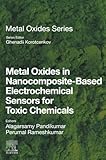Metal oxides in nanocomposite-based electrochemical sensors for toxic chemicals / edited by Alagarsamy Pandikumar, Perumal Rameshkumar.
Contributor(s): Pandikumar, Alagarsamy [editor.] | Rameshkumar, Perumal [editor.]
| Rameshkumar, Perumal [editor.] .
.
Material type:  BookSeries: Metal oxides series: Publisher: Amsterdam : Elsevier, 2021Description: 1 online resource (1 volume) : illustrations (black and white, and color).Content type: text Media type: computer Carrier type: online resourceISBN: 9780128207277; 0128207272; 9780128209394; 0128209399.Subject(s): Chemical detectors -- Technological innovations
BookSeries: Metal oxides series: Publisher: Amsterdam : Elsevier, 2021Description: 1 online resource (1 volume) : illustrations (black and white, and color).Content type: text Media type: computer Carrier type: online resourceISBN: 9780128207277; 0128207272; 9780128209394; 0128209399.Subject(s): Chemical detectors -- Technological innovationsPrint version record.
Metal oxide nanomaterials exhibit interesting electrical and photochemical properties because of their size, stability, and high surface area that render them as great choices in fabricating alternative electrode materials for electrochemical energy storage and sensor applications. The hybridization of metal oxides with other materials lead to the improvement in electrical conductivity, stability, and electron transfer kinetics during the electrocatalytic reactions. These key factors result in greater sensitivity of the sensor materials towards the analyte molecules. This book reviews the electrochemical determination of a variety of toxic chemical contaminants using metal oxide-based nanocomposite materials. Ultrasensitive and selective detection of toxic chemical contaminants is important and demanding, especially for monitoring and controlling environmental pollution. In recent years, metal oxide-based nanocomposite materials have shown high potential in the electrochemical detection of heavy metals, inorganic anions, phenolic compounds, pesticides, and chemical warfare reagents. Metal Oxides in Nanocomposite-Based Electrochemical Sensors for Toxic Chemicals comprehensively reviews this topic. In addition to the instrumental simplicity, the electrochemical methods show the improved sensor performance through the synergetic effect of metal oxide and other electroactive nanomaterial present in the nanocomposite. Thus, detailed information on the electrochemical sensing of toxic chemical contaminants using metal oxide-based nanomaterials are discussed. The recent progress in developing electrochemical sensors using metal oxide-based nanocomposite materials and perspectives on future opportunities in sensor research and development are addressed in the book.
Includes bibliographical references and index.


There are no comments for this item.